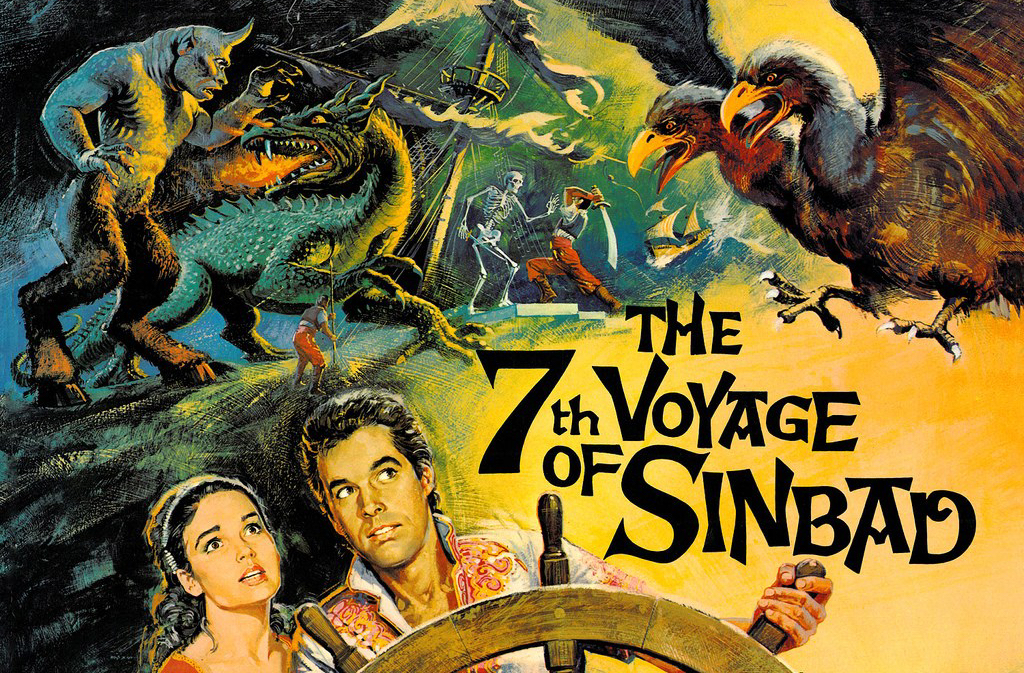Ray Harryhausen’s THE 7th VOYAGE OF SINBAD made a huge impact on my life. I first saw the 1958 film in a movie theater in a revival screening. My kiddie mind was blown away by the exotic fantasy scenario and the incredibly believable, emotionally involving creature battles. Afterward, I immediately set out to watch more of Harryhausen’s SINBAD movies and absorb as much of his other work as I could.
As I’ve said before, seeing Ray’s amazing creations in 7th VOYAGE aligned perfectly with Famous Monsters of Filmland magazine for me. After seeing that 1958 movie, I remember seeing the infamous Cyclops leering back at me from the cover of FM #118 on the newsstand — there was Ray’s one-eyed creature inviting me to find out more about the compelling cinematic experience I couldn’t stop thinking about. From that point, I was hooked on Famous Monsters too. 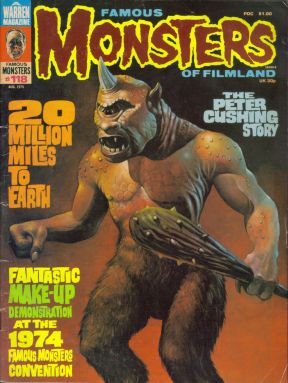
For the production of THE 7th VOYAGE OF SINBAD — which features such stop-motion wonders as a solo skeleton sword fight, a half-woman/half-snake dancer, a giant two-headed vulture and an epic battle between a towering Cyclops and a fire-breathing dragon — Harryhausen’s hands were actually insured for a million dollars.
One of my early pieces that I got to write for Famous Monsters was an appreciation of Ray Harryhausen‘s spectacular THE 7th VOYAGE OF SINBAD, with details on the making of the project, published in FM #271 just a few short months after Ray passed away in May of 2013. In celebration of the film’s 60th anniversary, I present my original article in its unedited form:

THE MAN WITH THE MILLION-DOLLAR HANDS: THE 7th VOYAGE OF SINBAD & THE BIRTH OF “DYNAMATION”
From the land beyond beyond, from the world past hope and fear, I bid you, Genie, now appear…
THE 7th VOYAGE OF SINBAD retains the honor of being one of the most entertaining and influential fantasy films ever made. The magical, escapist adventure full of intrigue, exotic locales, amazing monsters and a malevolent magician first astonished audiences upon its release in 1958, setting the bar for visual effects, courtesy of stop-motion animation wizard Ray Harryhausen. The film has inspired many of today’s most successful and respected filmmakers, from Steven Spielberg and George Lucas to Peter Jackson, John Landis, and contemporary stop-motion practitioners Tim Burton and Henry Selick.
7th VOYAGE finds Sinbad heading to Baghdad to marry the beautiful Princess Parisa and unite with her father’s kingdom of Chandra to avoid war. En route, the legendary sailor and his men anchor at Colossa Island to restock their supplies, only to encounter a deadly Cyclops and the fleeing magician Sokurah, who loses his magic lamp in the scuffle. They manage to escape and make it to the wedding, but before the happy couple can exchange vows, the treacherous sorcerer shrinks Parisa down to the size of a doll, coercing Sinbad to take him back to Colossa to obtain a crucial ingredient necessary to break the spell. Of course, Sokurah just wants that Genie lamp, and back on the mysterious island Sinbad must battle even more fantastic monsters and once again take on the Cyclops in order to return his bride-to-be back to a reasonable size.
Harryhausen’s attention to detail was legendary. Sequences that would last only minutes onscreen took months for him to painstakingly photograph, working by himself to command each creature’s movement-by-incremental-movement — he never called his incredible creations “monsters” — imbued with life one frame at a time. The results of that exquisite patience consistently yielded some of the greatest, naturalistic creatures of the silver screen, and that irreplaceable talent prompted producer Charles H. Schneer to insure Ray’s hands for no less than one million dollars, an unheard of precaution at the time, even by today’s standards when it comes to special effects technicians. But seeing as 7th VOYAGE would rely almost entirely on the spectacle of Ray’s patented process of Dynamation, it seemed to be a shrewd move on Schneer’s part.
Schneer and Harryhausen’s working relationship would last for more than 25 years and cover a dozen fantasy features. The producer said of his celluloid magician friend, “I’ve been witness to his genius. His scenes and his sequences and his delivery have been superb and unmatched as far as I know in the annals of the motion picture industry. It’s been a great pleasure of mine to see Ray at work: That power of concentration, his area of creative design, and his ability to do what today crews of 70 or 80 men are doing is certainly unmatched in cinematic history.”
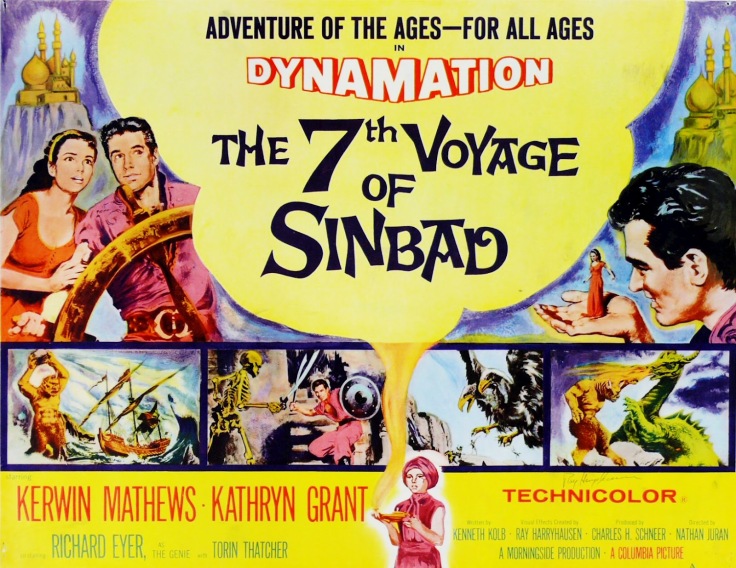
SINBAD AS A SOURCE OF INSPIRATION
The ambitious origins of THE 7th VOYAGE OF SINBAD began with a handful of drawings by Ray, starting with his simple desire to animate a skeleton. But who or what would it fight? He recalls, “My decision that the best adversary for this unusual villain would be Sinbad,” explaining, “I felt he was the personification of adventure.” He believed that audiences would more readily accept the ARABIAN NIGHTS character in a fantasy environment, and his escapades “often brought him into contact with sorcery and mysticism.”
Ray promptly put together an outline, drawings and sketches for a project called SINBAD THE SAILOR. Using 1940’s THE THIEF OF BAGHDAD as an example of a produced film that showed “just how exciting legends could become if the audience could actually see the fantasy creatures,” Ray pitched his idea to Schneer, who remembers that when he first saw those sketches, “I was absolutely overwhelmed by them, and I didn’t need anymore than those drawings to sell it to the distributor.”
The screenplay for 7th VOYAGE was then put together. Initially titled THE ADVENTURES OF SINBAD, it was ultimately changed after Ray recommended using the number 7 “for its mystical connotations.”
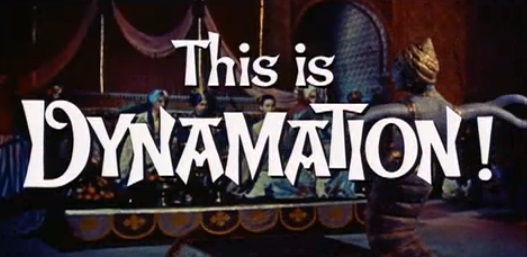
DYNAMATION, “THE NEW MIRACLE OF THE SCREEN”
Now that Columbia Pictures was sold on Ray and Charles’ proposal for a swashbuckling Sinbad adventure, the next challenge was figuring out how to translate Ray’s complicated effects to a color film palette. They had only been done in black-and-white, and Ray encountered brand new headaches in attempting to capture the realism of his stop-motion animation combined with live-action actors against his rear-projection process, now with the grainy color film stock. But after multiple tests, he was able to defeat his new Technicolor obstacles and hone his craft that he had established on such black-and-white classics as MIGHTY JOE YOUNG (1949) and 20 MILLION MILES TO EARTH (1957).
Meanwhile, the showman side of Schneer came up with a catchy new name for Ray’s technical process. Sitting in traffic in his Buick, he eyed the word ”Dynaflow” on his dash and had an epiphany: the word “Dyna” perfectly embodied Ray’s unique style of visual effects. Why not combine it with “animation”? As if Ray’s incredible creatures weren’t enough to sell the idea, now they thought they had the perfect gimmick to help market 7th VOYAGE.
Vintage trailers for the film announced that it was filmed “In Dynamation, the new miracle of the screen,” and a great promotional featurette, very much a product of its time, explained, “Dynamation is a new process which utilizes new technical and scientific advances in electronics and color to open up vast new vistas in motion picture entertainment. Anything the mind can conceive can now be brought to the screen.” It concluded with the declaration: “THE 7th VOYAGE OF SINBAD is the 8th wonder of the screen.” Indeed!
As times change, so do sales pitches, and the Dynamation name evolved with future projects to become known as “Super Dynamation” and then “Dynarama.” Call it what you will, it was still the same Ray Harryhausen magic.
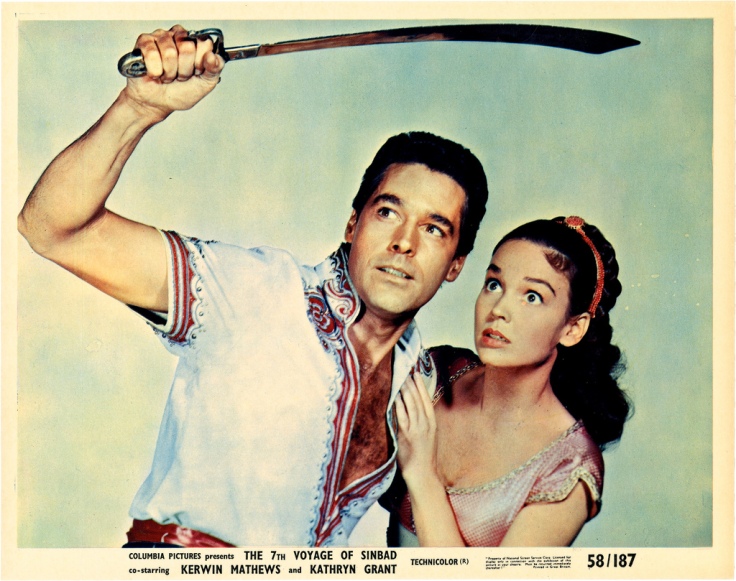
MAKING THE MOVIE AND CASTING SINBAD
THE 7th VOYAGE OF SINBAD’s release in 1958 was the start of a successful Sinbad trilogy for Ray that spanned close to two decades, with THE GOLDEN VOYAGE OF SINBAD in 1973 and SINBAD AND THE EYE OF THE TIGER in 1977 — considered a disappointment because it was “put together too quickly” on the heels of GOLDEN’s success. The extended period of time between the first and second SINBAD movies made room for other Harryhausen classics such as MYSTERIOUS ISLAND (1961) and JASON AND THE ARGONAUTS (1963), but the lack of success of THE VALLEY OF GWANGI in 1969 prompted Ray and Schneer to return to Sinbad’s adventures and give the Genie’s magic lamp another rub.
Three different actors took on the title role of Sinbad for those movies: Columbia Pictures contract player Kerwin Matthews was clean cut and square-jawed, and would team up with Ray on their next project as the title character of 1960’s THE 3 WORLDS OF GULLIVER. John Phillip Law played Sinbad in GOLDEN, while Patrick Wayne, the son of John Wayne, rounded out the bearded protagonists.
Schneer said Matthews “made a splendid choice for us,” explaining of the former teacher from Seattle, “He was handsome, he was vigorous, he was athletic, and he was totally dedicated to the job of being an actor.” Ray also observed, “This type of picture presents a big challenge to actors because they have to do what we call shadow boxing to a great degree. … I found out in THE 7th VOYAGE OF SINBAD that Kerwin Matthews was very talented at giving the impression that he was actually seeing something.”

Playing Sinbad’s love interest was Kathryn Grant as Princess Parisa. The Texas-born beauty made her screen debut in 1953’s FOREVER FEMALE and made a perfect damsel for Sinbad to save. Her character was also quite independently written for the time; rather than simply scream at Ray’s creatures like many a ‘50s B-movie heroine, Parisa had sufficient pluck and even came in handy to rescue Sinbad and his men from the dreaded Cyclops’s cage thanks to her diminutive size. Despite Grant’s promising turn, she retired from acting shortly after her 7th VOYAGE adventure when she married Bing Crosby. Torin Thatcher proved to be the perfect foil for Sinbad as Sokurah the Magician. Originally from Bombay, India, Thatcher was also a former teacher who made his screen debut in GENERAL JOHN REGAN back in 1934. And rounding out the cast as the young Genie Barani in the lamp was 12-year-old Richard Eyer, a Santa Monica-born, Los Angeles resident whose chief credit prior to 7th VOYAGE was 1957‘s THE INVISIBLE BOY. He went on to make multiple TV appearances in the next 10 years, and also left the entertainment industry. Eyer went on to become an elementary school teacher, perhaps due to the sage advice of his experienced male co-stars.
THE 7th VOYAGE OF SINBAD was formally announced to the world on June 20, 1957, and principal photography began on August 12, 1957, with director Nathan Juran at the helm. The Austrian-born filmmaker was previously an art director who won the Academy Award for Best Art Direction with 1941’s HOW GREEN WAS MY VALLEY; his directorial debut was THE BLACK CASTLE in 1952. 7th VOYAGE was shot primarily in Spain instead of in the story’s middle eastern setting, due to that region’s unstable conditions. Using a partial Spanish crew, it lensed in wide-ranging locations including Madrid, Barcelona, Granada, Sevilla, Mallorca, the beach at S’Agaro, Tossa de Mar, and the Caves of Arta. There was also some studio work in London, and after principal photography wrapped, Ray “worked his magic” in Hollywood and post-production was completed on March 7, 1958.
Of his first experience filming the movie, Matthews recalled flying to Granada, traveling to the remote palace set by horse-and-carriage, being dressed in a costume with jewels and a turban, and then meeting Ray, who told him on the bedroom set that he was going to be talking to a miniature princess on a pillow. Matthews concludes, “I spent the rest of that film looking for little Kathy Crosby or great big monsters.”
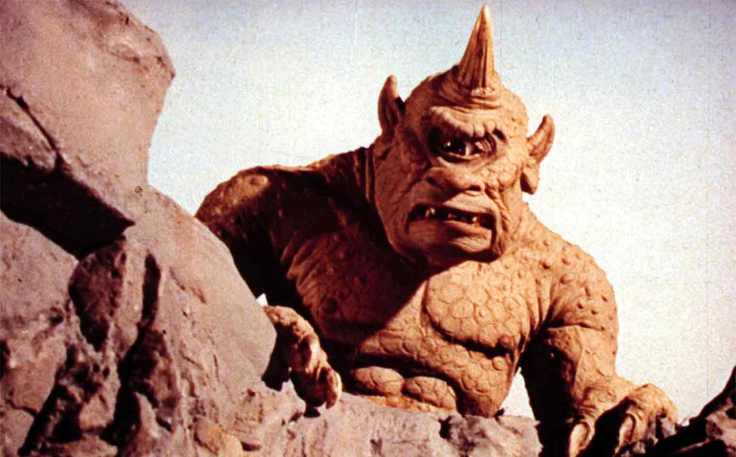
THE CYCLOPS OF COLOSSA
The first set piece out of the gate in 7th VOYAGE is our first encounter with the fearsome Cyclops, a character Ray lifted from the tale of Odysseus in Greek mythology, given some special modifications to make it his own: Pointed ears, scaly, with wart-covered skin and a ridged upper torso, three-fingers on each clawed hand, the legs of a satyr and cloven hooves, a crowning horn atop his head — and an animalistic roar that will give you nightmares for the rest of your days. One of the thoughts behind giving the Cyclops the legs of a satyr was to sell the idea to the audience that this was not a man in costume. Through the capable talents of Ray, the detailed stop-motion figure incredibly transmits clear emotions of anticipation, surprise, pain, anger, and frustration. When he licks his lips at the delight of snacking on Sinbad and his men, you can almost empathize with his desire. It’s little details like that one that made Ray’s work great.
“We tried to give him a proportion so that people would find him rather awesome,” recalled Ray of the Cyclops’ size. One of his signature creations, it was a character he had been plotting to put on film for years. His first attempt to bring it to the screen was in 1946 with an unrealized project called THE SATYR that introduced a variety of creatures in a secret underworld beneath a Mayan pyramid, including a Griffin, Sphinx, Medusa, and a Satyr along with a Cyclops; a few years later, another unmade project called THE LOST CITY had a Cyclops escaping to the surface to cause havoc; and the Ymir in 20 MILLION MILES TO EARTH was originally meant to be a one-eyed monster in a project called THE GIANT CYCLOPS. One doesn’t have to look too closely to notice that Ray’s Cyclops and his Ymir display a significant resemblance in their appearances, from the facial sculpt to the ready-for-action stance. They even share the same armature, as Ray pillaged the Ymir’s metal skeleton to use for the Cyclops.
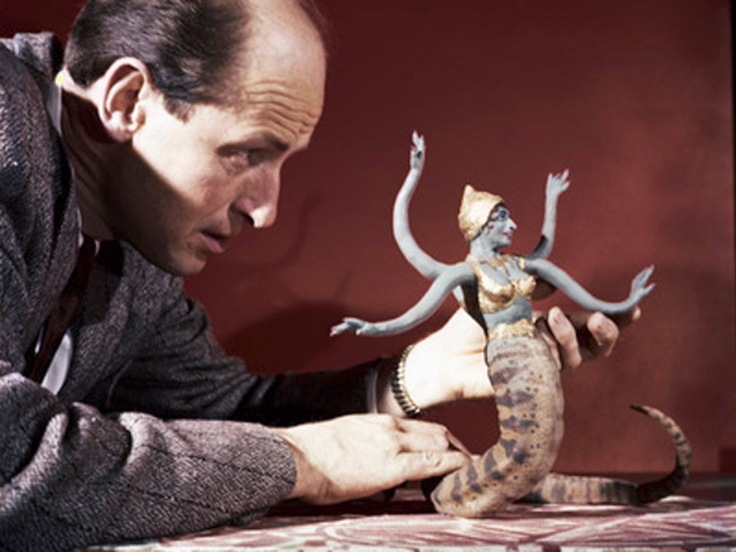
THE SERPENT DANCE AND THE SHRINKING PRINCESS
The next Harryhausen set piece finds Sadi, a handmaiden to Princess Parisa, transformed by Sokurah before a royal audience into an undulating half-woman, half serpent in a feat of magic. As everyone looks on mesmerized, the disturbing performance comes to a screeching halt when Sadi is almost strangled by her own tail. This creature was one of Ray’s favorite characters in the film. The meticulous artist added an extra set of arms to the creation, which gave “her whole body an allure and a flow that worked wonderfully with the music.” An astute observer of the human form and the art of movement, Ray studied belly dancers to lock down the serpent’s rhythm, joking, “This arduous piece of research involved me slogging round all the Los Angeles nightclubs I could find that were featuring belly dancers. Sometimes animators have to suffer for their art.”
As a major plot point of 7th VOYAGE requires the scheming Sokurah to shrink down the princess to smaller-than-Barbie proportions while she sleeps, yet another trick of the camera was devised to pull off the optical illusion. Kathryn Grant was filmed on a Madrid soundstage, tied to a stake to keep her motionless, as the camera focused on her arm. The camera then slowly moved back 40 feet to make it appear to get smaller. For the final stage of the gag, Grant was placed on a giant pillow, 25 feet high and 40 feet wide, to really sell the effect.
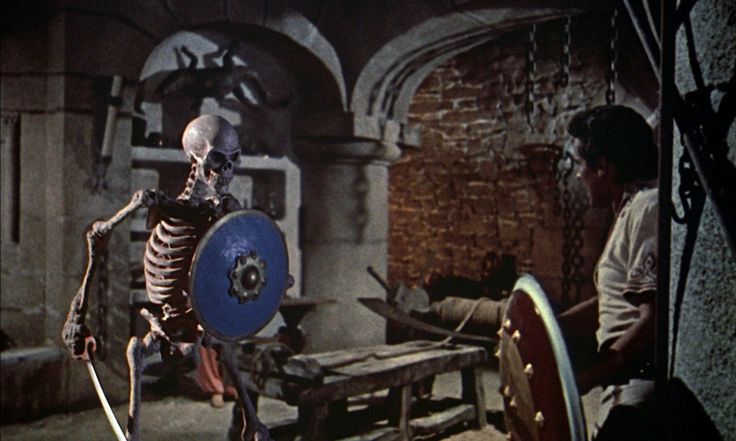
THE GROUNDBREAKING SKELETON FIGHT
JASON AND THE ARGONAUTS is perhaps best remembered for its exciting, four-and-a-half-minute, multiple skeleton sword-fight sequence, which took Harryhausen four and a half months to painstakingly photograph, requiring an estimated total of 184,800 individual movements. In order to accomplish this incredible feat, he first had to cut his teeth on the scene that inspired him to make 7th VOYAGE in the first place: Sinbad’s incredible one-on-one battle with Sokurah’s skeleton, animated to do battle by means of sorcery. In order to learn believable swordplay for the sequence, Ray once again dove feet first into his craft and learned the art of fencing, enrolling in a course at the Faulkner Fencing School on Sunset Boulevard in Los Angeles. “I must confess that I enjoyed it,” he recalled, “but I had to give it up when I threw my hip joint out. What we artists suffer for our art!”
When it was time to film the sequence, Italian Olympic fencing coach and sword master Enzo Greco was called in. The stunt supervisor for the film, Greco choreographed the intense fight and stood in for the skeleton to clash metal with Matthews, who shared, “We had to be so precise to make sure that the swords eventually met on the screen that we started counting. … Finally, we worked out that we were choreographing things exactly the way you’d choreograph a dance sequence in counts of eight … and with Bernard Herrmann’s music, it’s almost a dance sequence.”
The exact same fight choreography was then shot with Matthews going through the emotions alone, and the skeleton was matted over Greco’s performance. An interesting note: When 7th VOYAGE was released in England, the censors cut out this entire fight sequence, worried that it would frighten children. What a crime!
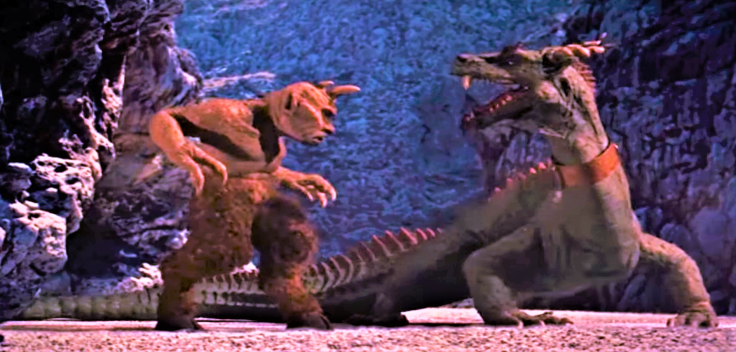
THE FIRE-BREATHING DRAGON
No outrageous fantasy adventure is complete without a fire-breathing dragon, and the creature designed by Ray for this film was thematically based on far eastern legends, with lethal fangs, a forked tongue and twisted horns attached to a reptilian body with “a touch of dinosaur,” of course. Ray loved dinosaurs! He purposely chose not to give the beast wings in order to keep the dragon grounded and the established story from changing too much. As for capturing believable fire coming from the mouth of a three-foot model, he filmed a flamethrower against a dark sky and superimposed it.
The climactic fight between the dragon and a second Cyclops took weeks to animate and is a true highlight of the film, with each creature drawing enough sympathy during their tussle that it’s hard to root for one over the other. Alas, there can be only one victor in Harryhausen’s law of the jungle, and ***SPOILER ALERT*** yet another Cyclops meets his doom. Sadly, only minutes later, Sinbad’s giant crossbow is assembled to defeat the dragon, and the mythical creature meets a particularly nasty end. One life-sized, 15-foot arrow was constructed for the production; the rest of the crossbow apparatus was actually a miniature that measured only two feet long, matted with a life-sized, eight-foot wheel that the performers would work in front of on the beach of S’Agaro.
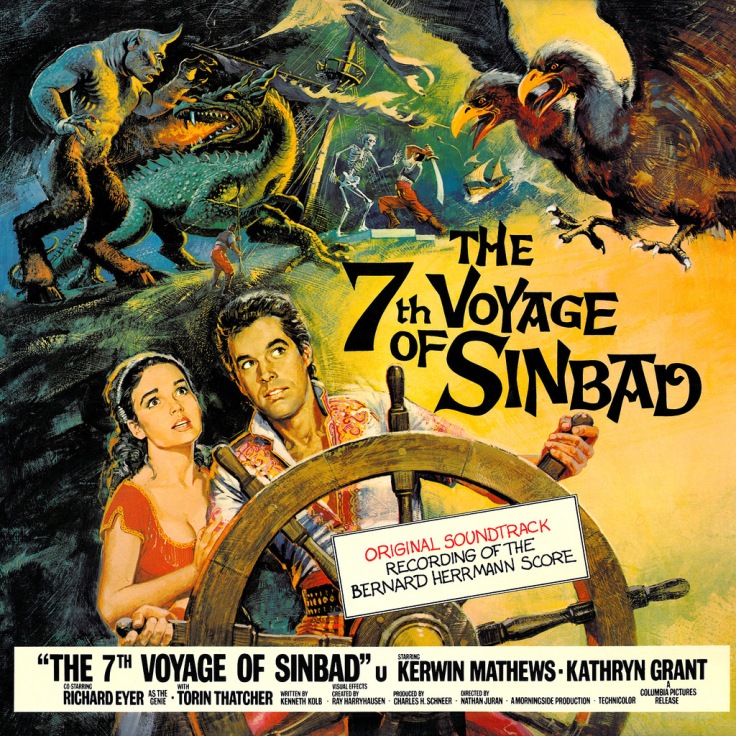
THE IMPORTANCE OF SOUND DESIGN AND HERRMANN’S MUSIC
Sound design is crucial for the believability of Ray Harryhausen’s collection of beasts. Imagine the Cyclops without his unsettling roar; the two-headed Roc without the gale-force flap of its wings; or the Skeleton warrior without the rattle of its bones? Growls, shrieks, groans, roars of terror, whines of pain and so many more innovative sound effects connect the viewer to each creature’s raison d’etre, key ingredients to making them look and feel real.
And without Bernard Herrmann’s incredible orchestral score for 7th VOYAGE, the puzzle is not complete. His music for the film is a character in and of itself, guiding the emotional tone of the entire proceedings. The veteran composer’s score is marked by a memorable, melodic overture full of harmony and excitement. Scenes are brimming with musical energy to serve the visual splendor of the film, courtesy of Herrmann’s trademark brass, chimes, bolstered percussion, and a full complement of woodwinds. And when it comes to Sinbad’s death-defying duel with the animated Skeleton, Herrmann’s use of clacking, snapping percussion and xylophone accompaniment wills the audience to believe that every bone of this formidable adversary is working together to take out our hero without remorse.
“The music is very important,” Harryhausen would point out. “I’ve always felt that 50 percent of the success of the fantasy film is the music. The music heightens the emotion and makes the whole thing bigger than life.”
Herrmann’s collaboration with Harryhausen and Schneer proved so successful that they collaborated on three more pictures: THE 3 WORLDS OF GULLIVER, MYSTERIOUS ISLAND, and JASON AND THE ARGONAUTS.
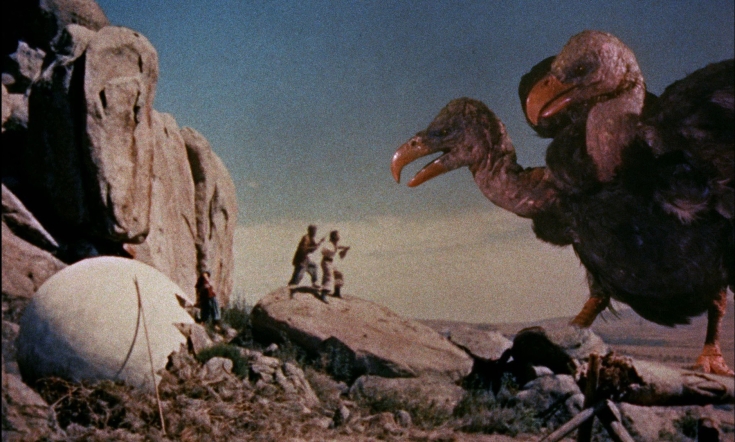
WHAT DIDN’T MAKE THE CUT
As with any creative endeavor that springs from creative minds, a lot more is put on paper than is ultimately burned on film. This happens for a variety reasons, from budget and time limitations to technological barriers. Harryhausen, however, was well-known for his tenacity when it came to inspirations like his Cyclops, and over the course of his storied career a good many creatures and sequences survived to tell their tale: “Few, if any, of my ideas were ever completely discarded,” said Ray. “Once I had pictured a creature in my mind’s eye, it rarely left me until I had realized it on paper or celluloid.”
The original outline for 7th VOYAGE had Sinbad seeking a mythical place called The Valley of Diamonds. He has to battle the Cyclops, who is a diamond miner, and penetrate a Fortress of Fear to get to the gleaming prize. After also battling a dragon, he confronts an adversary named the Lord of Fear in the crumbling castle, then encounters a hooded figure — Death himself — which is a skeleton, of course. They duel to the death, and Sinbad claims his untold riches.
The original 7th VOYAGE outline also had a scene in which Sinbad’s men break open the gigantic two-headed Roc’s egg, drag out the baby bird and kill it for food. Naturally, this angers its parents, who attack Sinbad’s ship with giant rocks, breaking it into two and sinking it. While that particular catastrophe didn’t make it to picture, the scene with Sinbad’s starving men noshing on the giant baby bird did make the cut, and Ray got to throw in a similar payoff again in a memorable MYSTERIOUS ISLAND sequence a few years later. I guess he liked his roasted chicken…

Other wild ideas for 7th VOYAGE included a scene in which giant rats released by Sokurah chase Sinbad and Parisa over a rock bridge; a sequence in which two Cyclops beasts fight over Sinbad’s caged sailors; an attack by “bat-devils”; sirens with mermaid tails; and a giant snake that chases Sinbad’s men up a huge tree. The rats and the snake ultimately got the axe from the script thanks to Schneer’s strong aversion to those creatures.
Ideas like these that never saw the light of day, and many, many others — like a film that Harryhausen wanted to make about the Abominable Snowman — ultimately ended up “filed away” in what Ray called his “story morgue.” And although they never got made, he came up with even more Sinbad movie concepts, including one in which our hero encounters dinosaurs, and two others titled SINBAD AND THE 7 WONDERS OF THE WORLD and SINBAD GOES TO MARS. Who wouldn’t want to see those Harryhausen movies?
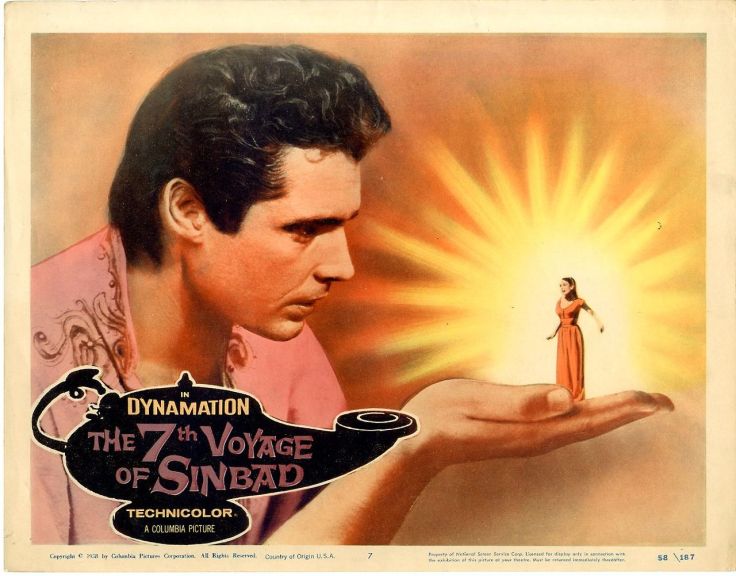
THE FILM’S RECEPTION
With a taut running time of 88 minutes, THE 7th VOYAGE OF SINBAD opened in December 1958. Photos taken in front of a New York City theater with a 7th VOYAGE marquee show huge lines of excited patrons, making for a genuine “blockbuster” opening. Produced for under $1 million (at a reported $650,000), the film grossed over $6 million in its initial release and was considered to be a sleeper hit. A true collaborative effort, what ultimately made the final product so special really had everything to do with Ray’s fancy footwork; people had never seen such a spectacle onscreen before, and had no clue how it was done.
Even Kerwin Matthews was surprised, saying of the finished picture years later, “When I finally got to see the film it was in a theater in Monte Carlo, and I couldn’t believe it was the same film I had worked on. Not at all. When all those monsters came to life and the Cyclops and all the special effects, I was just carried away as if I weren’t in it.”
Ray credited the runaway success of 7th VOYAGE with opening up opportunities he had never had before, and for changing the direction of his career: “I owe a great deal to Sinbad. … Up until 1958 I had been almost exclusively involved with so-called monster-on-the-rampage movies and was looking not only for a way out, but also for new inspiration.”
The feather in the “turban” for THE 7th VOYAGE OF SINBAD came in 2008, when it was selected for preservation in the National Film Registry by the Library of Congress and deemed “culturally, historically or aesthetically” significant, to be preserved for all time.
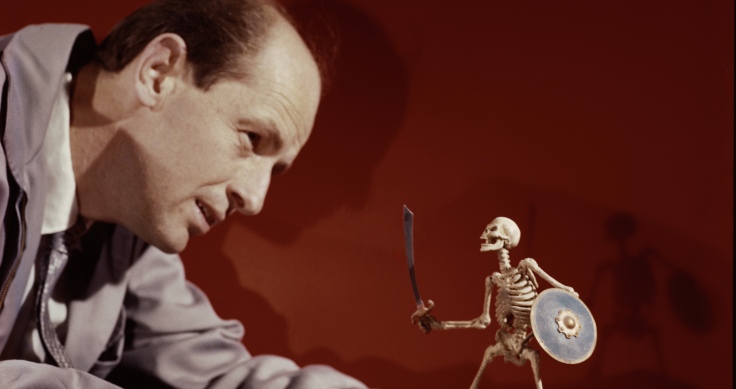
FOR THE LOVE OF FANTASY
As a lifetime lover of the cinema, I can less than a handful of films that truly changed my perspective between entering the theater and emerging two hours later a different person. For many people of my generation, STAR WARS was that experience. But before that, a mid-‘70s revival screening of THE 7th VOYAGE OF SINBAD rocked my world. Already a huge fan of dinosaurs and the Universal monster movies, I was entranced by Ray Harryhausen’s incredibly believable (for an eight-year-old) creatures and immediately set out to find as many films featuring Ray’s work as I could. I credit my adult obsession with multiple-armed religious icons to that spectacular scene in THE GOLDEN VOYAGE OF SINBAD in which the intrepid adventurer and his men battle a statue of the six-armed goddess Kali. As a kid growing up in suburban New York, I had never seen such an exotic statue like that before, and then to see it dance upon the command of a sorcerer — and then sprout six swords to engage in combat — simply blew my mind.
I spent many a Saturday afternoon watching Ray’s greatest hits on a small, black-and-white television. I couldn’t believe my luck when I’d be flipping around the dial and I’d catch the spectacle of a giant octopus tearing down the Golden Gate Bridge in IT CAME FROM BENEATH THE SEA, the desperate fight with a killer crab in MYSTERIOUS ISLAND, the insect-like aliens of FIRST MEN IN THE MOON, or a dino rampage in ONE MILLION YEARS B.C. And when I was older and had seemingly “seen it all” with the STAR WARS special-effects renaissance, a first-run viewing of CLASH OF THE TITANS took me right back to the wonder of the first time I joined the Cult of Harryhausen, notably with Ray’s stop-motion pièce de résistance: Perseus’ epic battle with Medusa, with shadowy close-ups of the Gorgon that were influenced by Joan Crawford in MILDRED PIERCE, and a moment that sees Medusa pulling her torso along that was influenced by Tod Browning’s FREAKS.
I can confidently say that in a new era of impressive CGI achievements that has become commonplace in practically every blockbuster made in Hollywood today, Ray’s work, while admittedly a bit crude by today’s effects standards, is exponentially more likable and tangible onscreen than, say, the CGI-overload travesty of a JOURNEY 2: MYSTERIOUS ISLAND. Contemporary visual effects remain cold and impersonal for the most part, and in comparison, Harryhausen’s finest moments represent the literal human touch lacking in today’s sci-fi and fantasy movies. Ray almost always earned the sense of wonder he set out to achieve.
If you’ve made it to the end of this article, you’re no doubt already a fan of the late Ray Harryhausen. If that’s the case, please take the opportunity to introduce someone new to his greatest hits with your own custom Saturday afternoon matinee. Keep his cinematic legacy alive, and once again appreciate the true artistry and wide-eyed wonder that brought real magic to the movies during his reign.
Credit where credit is due: For this article, many thanks go to The Ray & Diana Harryhausen Foundation for images that have circulated the Internet and for their enduring friendship; The Art of Ray Harryhausen, Ray’s Fantasy Scrapbook, and THE 7th VOYAGE OF SINBAD DVD extras from Columbia/Tri-Star Home Video for select Ray Harryhausen quotes (and Charles Schneer and Kerwin Matthews) and production details.
###
You made it to the end of the piece! You are a true Monster Kid. Now, please take a moment to “like” IT CAME FROM… on Facebook and “follow” on Instagram and on Twitter and/or Tumblr for more great retro content.
Then, check out more of my Ray Harryhausen stories and also many celebrity and filmmaker interviews HERE.
____________________________________________________________________________________
YOU CAN HELP IT CAME FROM BLOG“KEEP THE LIGHTS ON” WITH BUY ME A COFFEE. Thanks!

